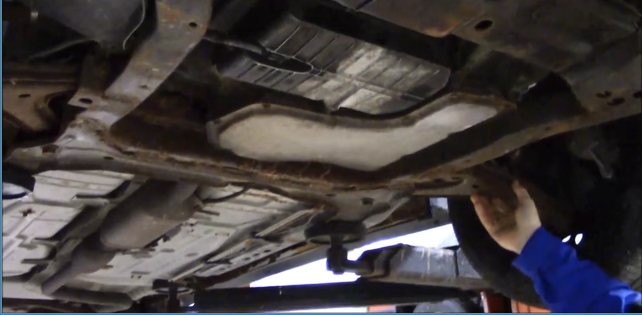[vimeo 204595440 w=640 h=360]
AAA De-Icer from dan goodman on Vimeo.
CONCORD, NH – According to a new AAA survey, U.S. drivers paid an estimated $15.4 billion in rust repairs caused by de-icing methods over the last five years, or approximately $3 billion annually. As the end of winter approaches, New Englanders will face pricey vehicle repairs from rust damage caused by chemicals used to de-ice roadways. AAA advises drivers to take action to prevent dangerous rust-related vehicle damage to brake lines, fuel tanks, exhaust systems and other critical vehicle components.
“While the application of de-icing salts and solutions is critical to keeping our nation’s roadways safe every winter, it’s important that drivers pay attention to warning signs that their vehicle may be suffering from rust-related damage,” said Pat Moody manager of public affairs for AAA Northern New England. “This can be much more than a cosmetic issue, it can also create serious safety issues for drivers by impacting brake lines, exhaust systems, fuel tanks and electrical connections.”
 AAA strongly urges drivers who experience any of the following vehicle malfunctions to immediately move the vehicle off the road to a safe location and have it towed to a trusted repair facility.
AAA strongly urges drivers who experience any of the following vehicle malfunctions to immediately move the vehicle off the road to a safe location and have it towed to a trusted repair facility.
- In-dash warning lights for brakes and other critical systems.
- A “spongey” or soft feeling when applying pressure to the brake pedal.
- An unusually loud exhaust sound or the smell of fumes in or around the vehicle.
- The prominent smell of gasoline or diesel fuel when the vehicle is parked or running.
In recent years, some state and local transportation departments have shifted from using rock salt to liquid de-icers to combat ice and snow on the roadways. These newer alternatives are more effective than traditional salt because they can be applied before a snowstorm, have a lower freezing point and melt ice and snow faster. However, these same characteristics can be even more damaging to vehicles since the chemicals remain in liquid form longer and are more likely to coat components and seep into cracks and crevices where corrosion can accelerate.
In 2010 The University of Maine released a report titled, Maine Winter Roads: Salt, Safety, Environment and Cost that outlined the use of salts on winter roads in Maine and the consequences of that use.
“In the last five years, 22 million U.S. drivers have experienced rust damage to their cars due to salt and liquid de-icers,” continued Moody. “In addition to the safety risk, repairs to fix these problems are often costly, averaging almost $500 per occurrence.”

While some rust damage is unavoidable, AAA recommends drivers take the following preventative steps in order to reduce the possibility of vehicle damage:
- When possible, limit driving immediately before, during and after winter storms when salt and de-icing solutions are being applied and are at their highest concentrations.
- Frequently wash your vehicle, paying particular attention to the undercarriage. This will loosen, dissolve and neutralize road salts. Many drive-through car washes offer an undercarriage rinse as an option.
- Get the bottom of your vehicle undercoated. It helps prevent moisture and compounds from getting into exposed areas and is designed to keep your vehicle’s undercarriage safe from rust and corrosion.
- Always use a high-quality car wash solution, not a household dish detergent that will strip the wax from your vehicle.
- Repair any body damage and touch up paint scratches and chips that expose bare metal which could lead to rust.
- Before the start of winter, thoroughly wash and clean your vehicle prior to the start of winter and apply a coat of wax to protect the finish.
- Give the entire vehicle and undercarriage one last cleaning in the spring. Any deposits left over from winter can continue to cause corrosion year-round if not properly removed.
Pothole damage is another concern for drivers, as snow and ice melt and roadways begin to crumble. A new AAA survey found that nearly 30 million U.S. drivers experienced pothole damage significant enough to require repair in 2016, with repair bills ranging from under $250 to more than $1,000. To address this issue, AAA believes that more funding is needed to keep pace with critical repairs and ongoing maintenance of the nation’s roadways.
When pothole or rust damage occurs, it is imperative to choose a reputable repair facility. The AAA Approved Auto Repair (AAR) network includes nearly 7,000 shops which have met AAA’s high standards, including, certifications, technical training, cleanliness, insurance requirements, rigorous inspections and customer satisfaction. AAA members are eligible for special benefits such as priority service, a 24-month/24,000-mile warranty, discounts, free inspections, dispute resolution assistance and more.
About AAA
As North America’s largest motoring and leisure travel organization, AAA provides more than 56 million members with travel, insurance, financial, and automotive-related services. Operating 19 offices throughout Maine, New Hampshire and Vermont, AAA Northern New England is a not-for-profit, fully tax-paying corporation and serves as an advocate for the safety and security of all travelers. AAA Northern New England can be visited on the Internet at www.AAA.com.







